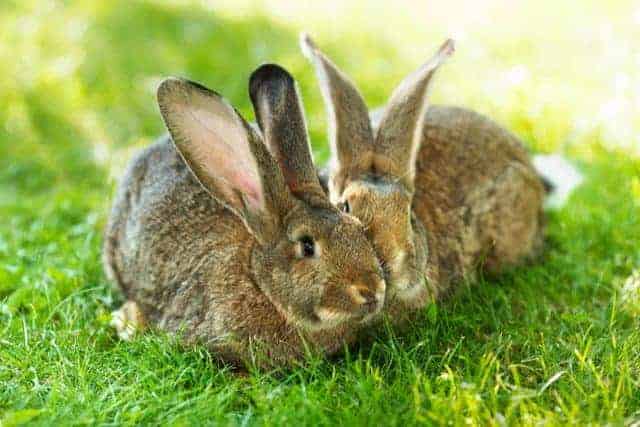
Learning to speak rabbit means spending lots of time engaging with and observing your bunnies, but the rewards for every rabbit owner are wonderful. Not only will you gain a fantastic insight into your rabbits’ world, you’ll also be better equipped to provide them with a more fulfilling life as you begin to understand what makes them happy, stressed or cross.
Chin rubbing
Rabbits have scent glands on their chins that they use to scent mark territories, objects and even people. Although humans can’t detect it, other rabbits can, and these scent marks mean: ‘This is mine!’.
Nose-nudging
This behaviour has multi-usage and can mean: ‘Pet me now’, ‘Pay me some attention’ or ‘Move out of the way!’.
Teeth clicking and grinding
Gentle, soft grinding of the teeth, almost like a cat purring, communicates contentment. However, loud grinding is a sign of pain or discomfort – your pet may also be hunched up as they do this. This is your rabbit saying: ‘I’m in pain’ and you should take them to the vet as soon as possible.
Ears on alert
Ears are like a rabbit’s radar, used for tuning in to what’s going on around them. Both ears forward mean: ‘Something has caught my attention’, one ear forward and one back can be interpreted as: ‘I’ve noticed something, but it doesn’t yet require my full attention’, both ears back suggest your rabbit is saying: ‘It’s all good and I can give my radar a rest’.
Licking
Two bonded rabbits will groom each other and licking is your rabbit’s way of telling you: ‘I like you’, showing that you have been fully accepted as a great bunny owner.
The binky
Binkying is the amazing acrobatic bunny jump accompanied by twisting the body or kicking the legs. Rabbits use the binky to communicate that they are feeling very happy and playful and that: ‘Life is great!’.
Circling your feet
If your rabbit starts to follow you around, circling your feet, they may be just trying to get your attention – ‘I’m here, let’s play!’ – but they could also be courting you. If your rabbit hasn’t yet been neutered, now is the time.
Mounting
Jumping on the back of another rabbit could also mean it’s time for an unneutered bunny to be spayed, but can also be interpreted as one rabbit telling another: ‘I’m the dominant one and don’t you forget it!’.
Lying flat
A belly-down rabbit with drooped head and ears held very flat is trying to blend in with their surroundings, revealing: ‘I’m really scared!’.
Flopped out
A rabbit that is sitting still or grooming may suddenly flop onto its side and lay still. This can look rather worrying, but it actually means: ‘I’m just so relaxed’.
Thumping
When a rabbit thumps on the ground with a hind leg, it can be surprisingly loud. This is the way rabbits – both wild and domestic – communicate danger to other rabbits. As well as saying: ‘I’m nervous’, your rabbit could also be communicating: ‘Please stop, I’m annoyed at you’.
The lunge
If your rabbit makes a sudden movement towards you with head and tail up and ears back, they are clearly telling you: ‘I don’t like that, back off’.
Nipping
Like a little pinch, nipping can mean several different things in rabbit language, from: ‘I want your attention right now’ to ‘I’m giving you a warning’.
Territory droppings
Droppings that are not in a pile, but are scattered, are a sign that a rabbit entering a new environment has decided that this territory now belongs to him.
Being vocal
Rabbits communicate with a whole range of vocalisations:
- Squealing or whimpering signal annoyance or displeasure.
- Grunting, growling, snorting and hissing communicate different stages of anger, stress or fear and may be followed with a lunge or nip. Rabbits grunt when they feel threatened, or to show their disapproval if they don’t want to be handled, essentially saying: ‘Leave me alone’. Some rabbits show their disapproval by grunting to protect what is theirs – a sleeping box, food or toys – from another rabbit.
- Honking or oinking, often accompanied by circling, suggests sexual interest.
- Screaming signals your rabbit is extremely scared or in pain – reassure them and take them straight to your vet.
Tail-wagging
If you notice your rabbit wagging her little tail, she’s not showing you she’s happy, she’s doing this as a sign of defiance. If you’re putting her back inside her run after a fun garden roaming session and she wags her tail, she’s back-talking you: ‘I don’t want to go in yet!’.
Chucking stuff about
As part of play or because they don’t like the way you’ve rearranged items in their accommodation, rabbits will push or toss objects around – from toys to bowls. It’s likely they could be saying: ‘Keep your hands off my stuff!’.
FIND OUT MORE about how to help your rabbits lead happy and fulfilling lives here
FIND OUT MORE about caring for your rabbits here
Sources: rabbitresource.org, thespruce.com, rspca.org














